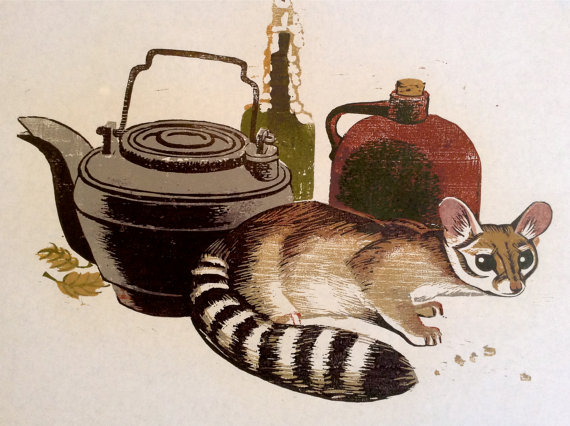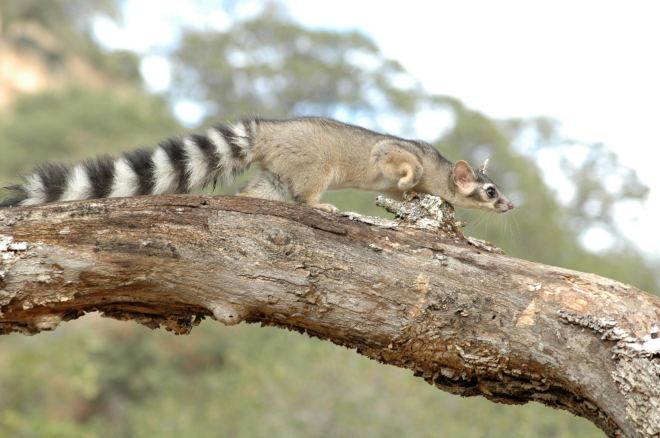
If you are ever lucky enough to lay eyes on a ringtail, you first thought will probably be something like: “What was that?! It looked like a fox crossed with that wacky lemur character from the movie ‘Madagascar’!” Ringtails are hard to categorize. Edward Abbey, famed lover of our desert landscape described the ringtail in “Desert Solitaire” as “an animal that looked like a cross between a raccoon and a squirrel.”
Abbey came pretty close to getting it right. The ringtail (Bassariscus astutus), also know as a “ringtail cat” is not a cat at all, but a relative of the raccoon. But unlike its masked and cosmopolitan cousin, the ringtail is specialized for the desert. It is slender, with a long, black and white ringed tail and short legs. Ringtails are much smaller than raccoons, weighing less than three pounds and are about two feet long from nose to tail-tip.
This desert dweller has skills that would make the most avid rock climber, parkour enthusiast or “American Ninja Warrior” fan envious. Their ankle joints can rotate 180 degrees giving them tremendous grip and their long tail aids in balance. They have been observed using the climbing technique of “stemming” to move up vertical rock faces–wedging themselves in a crack with two paws on each side and walking up it. If the crack is too wide for this, they may ascend it by bounding back and forth between the walls of the crack like a pinball defying gravity.
The ringtail ranges throughout the southwestern U.S. and Central America. It favors rocky, desert habitats with sources of water. Like raccoons, ringtails are omnivores but their diet tends more towards meat. They eat insects, lizards, juniper berries, prickly pear, other fruits and especially rodents.
In the past, miners made pets of ringtails because they were such effective mousers and kept cabins, mines, and camps free of rodents. This earned them the nickname “miner’s cat.” Ringtails are supposedly relatively easy to tame. It is now illegal to keep ringtails as pets in Colorado– cute as they are, they belong in the wild.
Perhaps the most notable characteristic of ringtails, besides their tails, is that they are elusive. They are almost exclusively nocturnal, very shy and pretty solitary. Most people only see ringtails on the side of the road after the animal has been hit by a car. If you know what to look for, you might spot their tracks in the mud after a rain in a canyon bottom. Like raccoons, all five toes on a ringtail’s foot are visible in its tracks, however they are not “finger-like” as in a raccoon. Ringtails walk more on their toe pads like a cat.

Ringtails are currently considered a “species of least concern” by wildlife conservationists, but their elusive nature makes it hard to be certain how ringtail populations are faring. David Wyatt, a wildlife biologist who studies ringtails in California says they “appear to be locally abundant in some places, but rare to not present in other places that you should reasonably expect them to occur. So, range maps are merely guesses and their true status is just not known.”
Colorado is not monitoring ringtail populations at this time, but local Colorado Parks and Wildlife biologist Dan Neubaum said he’d be interested to hear if ringtails have been spotted in the area, especially if the sighting is confirmed with a photograph. You can contact Neubaum via email at Daniel.Neubaum@state.co.us.
The rocky canyon country surrounding the Grand Valley appears to be very suitable habitat for ringtails, but sightings are rare. Perhaps a keen-eyed and lucky member of our outdoor recreation community will catch a glimpse of this desert phantom. Maybe a hiker will snap a photo of a distinctive five-toed track near a pool in the Colorado National Monument. How enchanting would it be to know that after the sun sets, the ringtails are at play in our canyons?

Special Thanks to biologist David Wyatt for his excellent photos of ringtails. Please check out his blog http://bassariscus.me
This article first appeared in the September 26, 2015 issue of the Grand Junction Daily Sentinel

Many years ago (late 80’s?) I had a ringtail inside a horse arena at dusk. We lived on 24 1/2 Road just a few hundred yards from Mesa Mall.
He was sort of sequestered on a cross beam about 6′ off the ground. I called DOW and they said just leave him. He was of course gone the following morning.
I enjoy your posts very much. Thanks!
Jim Grady, DVM
>
Thanks Jim! I am jealous. I still haven’t seen a ringtail. I think I need to wander around the desert more at night!